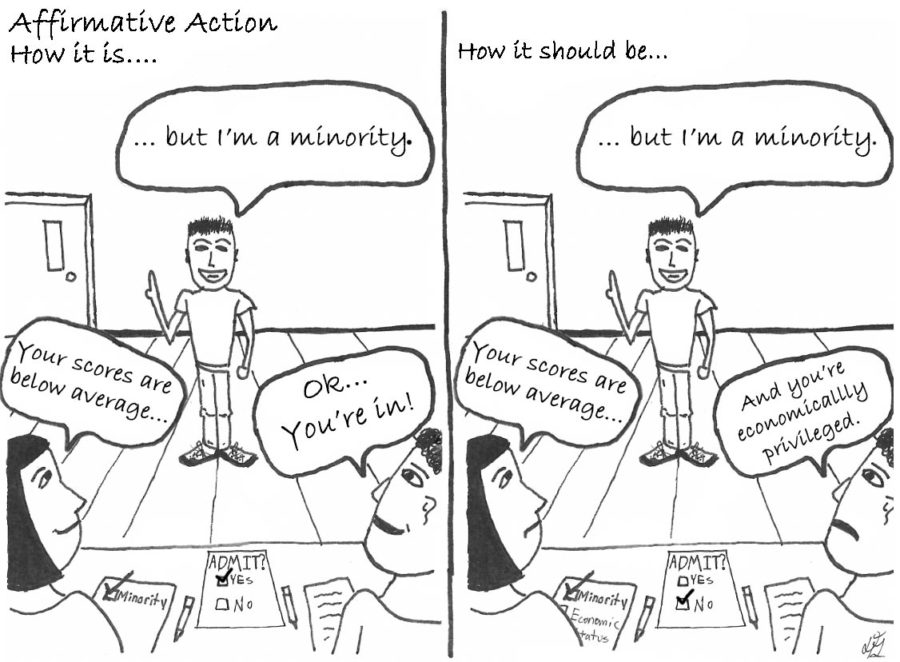Staff Editorial: Making Affirmative Action More Effective
In light of the Harvard Court Case, affirmative action is brought back to attention. With the rising controversy between recognizing academic decisions and promoting diversity, it is crucial to understand the original purpose of affirmative action: promote a diverse campus and support disadvantaged students. However, rather than solely looking at race, it should simultaneously analyze racial background, socioeconomic status and demographics.
Although it supports disadvantaged students, affirmative action has also angered many who may have a difficult time being admitted to certain schools due to their classification as a student of a majority race. Such feelings of resentment are apparent, as proven by the 1960 Regents of University of California vs. Bakke, a court case eliminating the review of race in applications. This legal precedent signals an important detail: affirmative action is not assessing all the factors that tie into diversity.
By redefining affirmative action, colleges must begin to analyze socioeconomic status, such as family income, and the demographics of a student, such as where the student has matriculated.
According to research by Alyssa VanderStel from Grand Valley State University, “a lower family income left students struggling to achieve in class. Factors that a school is able to control, such as educational level and teaching experience of the staff, have little to do with student performance; but socioeconomic factors present in schools seem to significantly influence a student’s ability to succeed.”
Public education systems of certain districts could vary drastically to other well-funded districts. Because both demographic (the resources offered at high school) and socioeconomic (family income) are out of an applicant’s control, implementing these into the affirmative action process helps eliminate specific racial discrimination while encouraging the idea that education can still be accessible.
Certain students are given access to resources that nurture academic growth, but this is relative to where the student has studied, or how much money a student’s family is willing to invest. An underachieving student could be from a lower socioeconomic background, which could justify admission over a high-achieving student from an affluent family; however, just admitting students from a minority race over a student classified as a majority with high SAT scores has proven to be problematic.
While removing affirmative action altogether may seem to be a plausible solution, its effects on the UC systems have shown to limit diversity significantly. According to the National Conference of State Legislatures, “statistics show that after California abolished its affirmative action programs in 1998, the minority student admissions at UC Berkeley fell 61 percent, and minority admissions at UCLA fell 36 percent.”
Research has proven that learning in diverse environments brings benefits for all enrolled students that cannot be easily obtained otherwise. According to Jeremy Hyman and Lynn Jacobs in an article from the U.S. News and World Report, “diversity enriches the multiple perspectives … helping to liberate you from the tunnel vision of an ethnocentric and egocentric viewpoint.”
Similar to how diversity does not just entail the percentage of students of a certain race, the admissions process is also not to be looked at through the lens of just race; it must also emphasize socioeconomic and demographic diversity. Expanding affirmative action is essential to achieving diversity on a campus as it benefits not only the minority race, but the campus as a whole, including students of a majority race.
Your donation will support the student journalists of Portola High School. Your contribution will allow us to purchase equipment and cover our annual website hosting costs.

Dylan Gates is the Media Director of the 2018-2019 Portola Pilot staff. He is in his Junior year at Portola and has been working with the Pilot since the...





John | Nov 13, 2018 at 5:30 pm
Alici, whoever you are, I sincerely hope you read this comment. Telling people to redirect energy into increasing test scores is, in the nicest terms I can think of, severely ignorant. I don’t know anything about you or your background, so I am trying my best not to target you, but for you to target the writer of this article without any background is absolutely unequivocally wrong. Moving past just your wonderful comments about the writer, I’d like to argue that a problem with affirmative action is it’s flawed view on equity. Equity would be giving everyone the same chance. This DOES NOT mean everyone should get the same result. If affirmative action is its belief to give everyone the same chance to attain a certain goal or skill, then by all means I am for that too. What becomes an issue is when colleges take equity and assume that just because someone has not performed as well, they must have had less chances growing up. Call me elitist or criticize the opportunities I had growing up, I don’t mind. I do not deny many people have it harder off in life, nor do I want to sound distanced from the argument, but the idea that you can criticize writers for an opinion by personally attacking them is just plain wrong. Just returning the favor <3
Jimmy Kang | Nov 13, 2018 at 3:51 pm
You know that fish shaped bread in Heritage Plaza? I just figured out they have a spam and a kimchi combo and it’s so good. I recommend you guys try it.
Renee | Nov 9, 2018 at 4:27 pm
This article and the accompanying comic seem to great simplify a complex problem. We could delve into all the different ways this country has systematically stolen from from minorities at the benefit of the majority (whites), but that would take too long. I’ll keep it sweet and say this, IF the affirmative action system is unfair, it comes no where near equaling the horrendous injustices done to black, brown, and red people in this country. And yet we hear more complaining about that than, let’s say, the destruction convict leading caused in the black community, the war on drugs in black and brown communities and the constant targeting of black and brown men in our current “justice” system. God forbid though, someone with a 3.0 get into college, a college that in fact, not too long ago, would’ve excluded them SOLELY on their minority status. How do you think that affect, let’s say, the practice of admitting people based on legacy? Maybe, people just have a problem with anything that is built to help minorities.
Sam | Nov 9, 2018 at 3:05 pm
In poor taste
Hania | Nov 9, 2018 at 2:49 pm
Just LOUD and WRONG. Simple minded and kinda pathetic. Next.
Alici | Nov 9, 2018 at 2:42 pm
Wow… this article (or perhaps the author himself/herself) is, in the nicest terms I can think of, severely ill-informed. I applaud your attempt to come across as well-researched by referencing the Regents v. Bakke case, but ultimately the illustration and rest of the article… the racism jumped out. I hope you redirect the energy you put into pointing out why affirmative action is unfair into increasing your test scores and bettering your application materials so that you can get into the school over the minorities you think have an advantage over you. Fun opinion though.